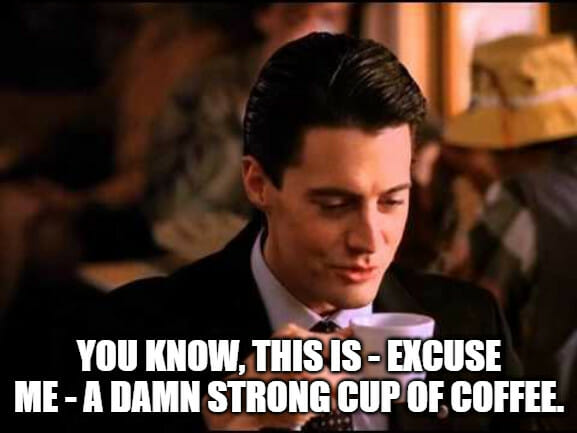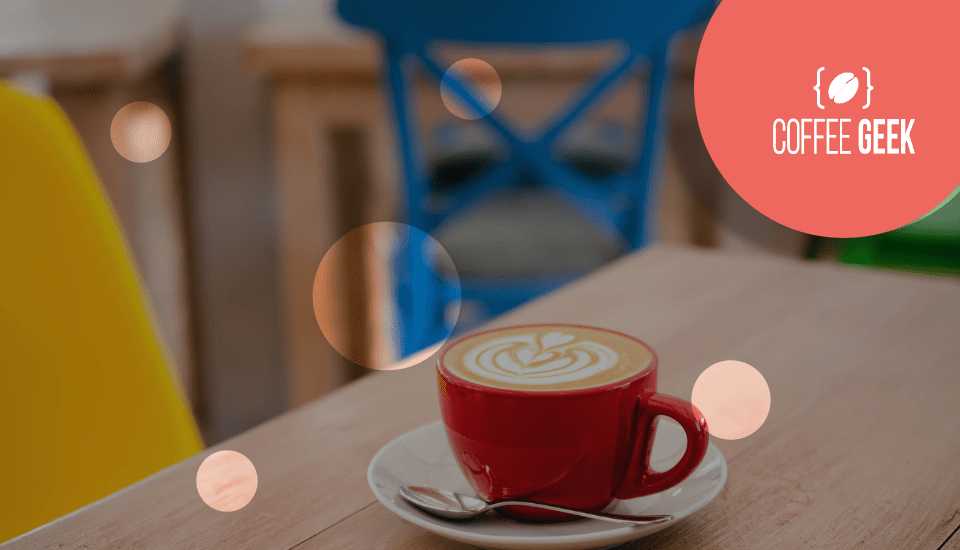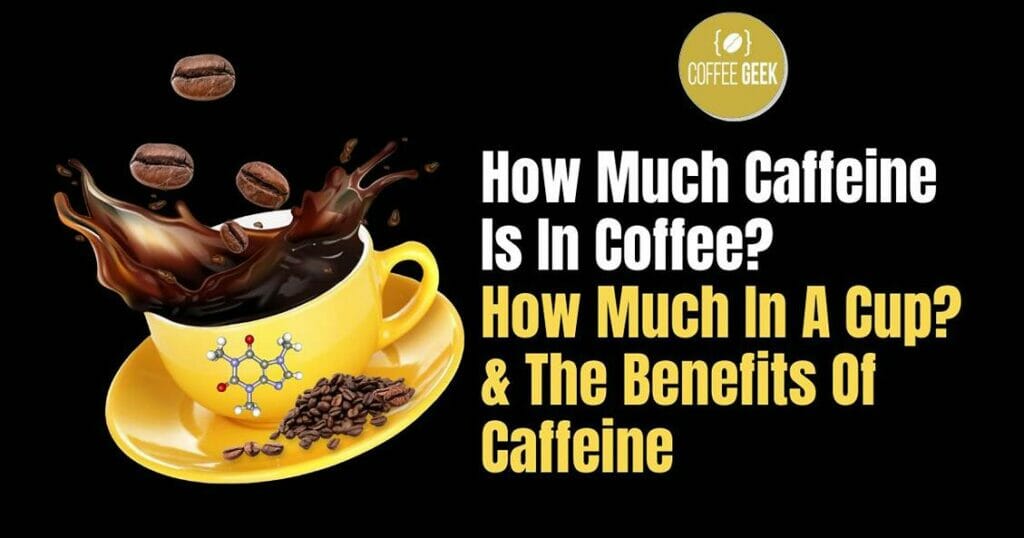We all like our dose of liquid energy. We call it mud, java, joe, dirt, bean juice… Truth be told caffeine really is a drug. Caffeine is the most popular and most consumed psychostimulant on Earth.
So, how much caffeine is in a cup of coffee? And how much is too much?
In this article, we deep dive on all things caffeine, uncover hidden truths and debunk a few myths.
There’s one things you should really know when comes to caffeine to shouldn’t be disregarded, but I’ll go into depth on that later.
For now, let’s take a look at answering all the questions you have about how much caffeine (or coffee) is ok to drink.
- What Is Caffeine?
- Where Can We Find Caffeine?
- How Much Caffeine Is In A 12 OZ Cup Of Coffee?
- Is 200mg Of Caffeine A Lot?
- How Much Caffeine Is In An Average Cup Of Coffee?
- How To Brew Strong Coffee?
- Is There Caffeine In Decaf Coffee?
- How Much Caffeine Is In Coke vs Coffee?
- How Much Caffeine Is In An Espresso Shot?
- How Much Caffeine Is In Energy Drinks And Chocolate?
- Which Has More Caffeine, Coffee, or Tea?
- Difference Between Caffeine And Theine
- How Much Caffeine Is In Cocoa Beans?
- Caffeine intake for different groups of people
- 8 main benefits of caffeine (and coffee)
What Is Caffeine?
Since Friedlieb Ferdinand Runge isolated this alkaloid substance in 1819, we got used to a daily intake of C8H10N4O2.
It has toxic, medicinal, and recreational effects, and even if several plants, nuts, and fruits contain caffeine – if you master the process (brew coffee) of getting it out of coffee beans – receptors on your tongue and in the central nervous system will thank you.
Fun fact:
Mr. Runge was a colleague and a friend of the German writer Johann Wolfgang von Goethe!
Where Can We Find Caffeine?
In nature. About 60 species, from beans, fruits, nuts, to leaves, contain caffeine – the main ones being:

Coffee Beans
In general, Robusta beans (canephora) contain more caffeine than Arabica beans
Cocoa Beans
These seeds from the cocoa pod contain two chemical substances, theobromine, and caffeine. I will talk about both of them later in the article
Tea Leaves
Did you know that tea is harvested by hand? Tea also contains 2 main substances, caffeine, and theine, plus several vitamins, minerals, fluorine, etc.
Kola Nuts
Kola nuts are mainly famous for being a flavoring ingredient in our soda drinks. The caffeine we ingest from Coke comes from this plant. Kola nut is also an ingredient in pharmaceuticals and herbal supplements.
Yerba Maté
This plant native to South America got popular because of indigenous people steeping it and preparing a healing (and tasty) drink. It is still very popular in Brazil, Argentina, or Paraguay.
This plant is high in antioxidants and has anti-carcinogen effects. Now, you can even get a bottled Maté drink in a shop.
Yaupon Holly
This plant with unpleasantly sounding name, Ilex vomitoriais, is native to the SouthEastern United States. Native Americans used it to prepare a tea full of antioxidants.
Guarana Berries
Guarana is a popular ingredient of energy drinks because it reduces fatigue.
Guayusa
A drink from this plant was called “the night watchman” by indigenous hunters of Amazon Forest. Nowadays it is widely consumed in Ecuador.
How Much Caffeine Is In A 12 OZ Cup Of Coffee?
12oz (340ml) is the usual “M” size of drinks. Most 12-ounce cups of coffee contain 90 to 120 mg of caffeine, but Starbucks, for example, can go up to 255 mg of caffeine per cup – for Iced Blonde Caffè Americano.
Do not be alarmed – it is safe to drink, just read further:
Is 200mg Of Caffeine A Lot?
Short answer: it depends on your health status.
Long answer: The world-famous Mayo Foundation states that up to 400 milligrams of caffeine a day is safe for most healthy adults.
Caffeine side effects include muscle tremors (shaking), irritability, nervousness, insomnia, headache, fast heartbeat, bladder issues, even caffeine dependency.
Always try to know your coffees, their approximate caffeine content, and drink enough water (67–101 oz)
If you still feel too “pumped up” it might be the tea, chocolate, energy drinks, or even painkillers. I will look at the caffeine contents of these items later in the article.
PS: Did you know that if you use a weight-loss supplement, it can contain 6 mg/g to 27 mg/g of caffeine?
How Much Caffeine Is In An Average Cup Of Coffee?
The average cup of coffee (8 ounces) contains 90 to 120 mg of caffeine. The final number depends on:
- Type of beans. Robusta beans have almost double the amount of caffeine, compared to Arabica.
- Type of roast. The longer your beans were roasted, the more caffeine content was lost.
- Type of grind. The finer the grind, the higher the amount of caffeine (just look at espresso!)
- Brewing time and method. Boiled and percolated coffees have more caffeine than filtered coffee.
- Your choice of coffee drink. Did you know that two of the strongest coffees in the world are called Death Wish (728 mg), and Biohazard (928 mg)? However, the strongest coffee per serving that you can make at home without needing special beans is a 16 oz serving of nitro cold brew, that can have around 300 mg of caffeine in it. If you want a small drink with a kick, go for espresso, ideally a double shot.
- Your choice of serving size. Brewed coffee typically contains around 95 mg of caffeine. The caffeine content of Cold Brew is 153 mg and 238 mg of caffeine. Everything can be made big(er)!
Espresso is the most popular drink with high caffeine content because one shot (or two) of espresso can be turned into many coffee drinks, such as:
- Americano –1/3 espresso and 2/3 water.
- Latte –2/3 espresso, 1/3 steamed milk, foam on the top.
- Cappucino –1/3 espresso, 1/3 hot milk, and 1/3 milk foam.
- Macchiato –a double shot of espresso and steamed milk.
- Cortado –a double shot of espresso and the same amount of milk.
Fun fact:
According to Statista, the top 5 countries in estimated average per capita coffee consumption (in kg) for 2020 were: Netherlands, Finland, Sweden, Norway, and Canada! Nothing like a cup of warm joe in cold, grey weather, I guess :)

How To Brew Strong Coffee?
Strong coffee is not bitter or does not make your face go eww. It is about mathematics.
If you tried espresso and you want to brew coffee that has more kick, you need to adjust your ratio aka add more grounds but keep the water quantity.
Most brew methods use a coffee to water ratio that falls between 1:18 and 1:16 (1 part coffee and 18 to 16 parts hot water).
When you add hot water to coffee grounds, it dissolves particles in coffee beans without breaking them (caffeine breaks only at the temperature of 455°F and causes extraction.
If adjusting the ratio did not work, I would suggest you swap Arabica for Robusta, look into darker roasts, your extraction time, or a different brewing method in order to brew coffee that tastes stronger. Why?
Darker roasts have a rich and bold flavor. Look into dark roasted arabica beans. I like the choco-tones of brews made with them.
Hot water (195 to 205 degrees Fahrenheit) and extraction time between 3-5 minutes were always “the norm.”
Brewing methods that take a longer brewing time, for example, drip coffee, or French press, usually result in a coffee that tastes stronger and richer. The cold-brew method of brewing coffee, made by dripping, direct or indirect immersion, or by the French press method, also gains more and more popularity.
Is There Caffeine In Decaf Coffee?
Just like non-alcoholic beer, decaf coffee can have traces of caffeine. 8-ounce decaf coffee contains 0–7 mg of caffeine per serving. 8-ounce decaffeinated instant coffee contains even more, 27-100 mg of caffeine.
For example, Starbucks Decaf Coffee contains 15 mg of caffeine (Short/8 oz), 20 mg (Tall/12 oz), 25 mg (Grande/16 oz), and 30 mg (Venti/20 oz)
How Much Caffeine Is In Coke vs Coffee?
Coca-Cola was invented 67 years after the discovery of caffeine. They sold only 25 bottles in their first year.
Nowadays, more than 10,000 Coca-Cola, Dr. Pepper, and Fanta soft drinks are consumed per second.
A 12-ounce can of Coke has a caffeine content of 34 mg, which is a third of a cup of regular coffee (12-ounce coffee contains 90–120 grams.)
It might shock you, but a Diet Coke contains more caffeine – 46 mg.
12 oz-serving size competitor drinks have the following caffeine content:
- Pepsi – 38 mg
- Pepsi Diet – 34 mg
- Pepsi Zero – 69 mg
- Dr. Pepper – 41 mg

How Much Caffeine Is In An Espresso Shot?
According to USDA, a shot of espresso contains about 63 mg of caffeine and averages at 1–1.75 oz. If your espresso-based drink is a large one (with a double shot) it contains about 125 mg.
Espresso-based drinks with two shots of espresso are any Doppio (double espresso coffee drinks), Cortado, Long Macchiato. Sometimes Caffè Americano, original Aussie Flat white…
To compare two big coffee chains and caffeine content in their one shot of espresso: at Starbucks, one shot of espresso contains 75 mg of caffeine; Costa Coffee’s shot of espresso contains approx. 92 mg of caffeine.
How Much Caffeine Is In Energy Drinks And Chocolate?
Both are sweet and give you energy. How much? A single 8-ounce can of Red Bull contains 80 mg of caffeine, while a single 16-ounce can of Monster Energy drink contains 160 mg of caffeine.
Do you scream for ice cream? 4 oz of Häagen-Dazs Chocolate Ice Cream has 5 mg of caffeine in it, while Häagen-Dazs Coffee Ice Cream has 29 grams!
Hot cacao in winter is lovely. And you can hardly overdose: 1 Tbs of Hershey’s Cocoa contains 8 grams of caffeine.
Cacao also contains theobromine, from the same family of stimulants as caffeine, but without the negative effects, or strong kick. No wonder that Mayans called it “food of the Gods.”
However, you should watch your sugar intake with all of the above. Only 120 to 200 calories per day should come from sugars (calculated for a regular 2,000 calorie diet.)
Which Has More Caffeine, Coffee, or Tea?
Tea leaves do contain more caffeine than coffee beans. However, as I wrote before, it all depends on the type of drink and how it was prepared.
Green tea in general contains less caffeine than black tea.
On average, one cup of brewed green tea contains 28 mg as opposed to black tea, which contains 47 mg of caffeine. And yerba maté contains roughly 85 mg of caffeine per cup, which makes it stronger than tea, but weaker than coffee.
Plus, coffee beans need to be brewed at a higher temperature, so you will get a stronger concentrate in your coffee cup, than tea. Usually two cups of tea = one cup of coffee.
On the other hand, tea also contains L-theanine.
Fun fact:
Statista Global Survey from 2020 found out, that even a tea-loving country like Britain might drink coffee more! 64 percent of the people surveyed drink coffee regularly.

Difference Between Caffeine And Theine
L-theanine aka theine also affects your nervous system. However, coffee and caffeine stimulate fast, give you the kick and the effect fades within 4 hours.
Theine relaxes you, and not in a drug/drowsy way. It even sharpens your senses, but also not in a “jumpy coffee” way.
Theine spreads in your system for a longer time than caffeine, up to 7 hours. Same as with coffee, steeping time affects how strong your tea will be.
The longer, the stronger. If you want some caffeine kick even from your cup of tea, steep it for 3–5 minutes.
How Much Caffeine Is In Cocoa Beans?
100 grams of cocoa beans contain 230 mg of caffeine. However, processed Cocoa Nibs contain only 12 mg of caffeine per 1 tablespoon.
If you like to sweeten your life – the darker the chocolate, the higher the caffeine content:
The white one does not contain any – or only minimal traces of caffeine. Milk chocolate contains about 9 mg and dark one 12 milligrams.
Caffeine intake for different groups of people
Who should be a bit more cautious when it comes to caffeine intake?
- Pregnant women – Some sources recommend to minimize it as much as possible, some only to stay below 200 mg, as opposed to the usual 400 mg rule.
- Breastfeeding women – Only a small amount of caffeine is passed through breast milk, but it is safe to stay below 300 mg of caffeine.
- Kids and teenagers – Kids do not drink coffee, but they receive caffeine in sodas. The American Academy of Pediatrics suggests that between the ages of 12 to 18, 100 mg intake of caffeine is maximum.
- Seniors – People above 65 metabolize caffeine slower, so coffee is not recommended late in the evening and the daily intake should not go over 200-300 mg.
- People that work out – Pre-workout supplements contain high amounts of caffeine, so bear that in mind. Many people opt for a diet coffee drink called Cold Brew.
- People with sleep issues – Even 100 mg caffeine intake close to bedtime increases the chance of side effects such as sleep-related issues and decreases sleep duration. Coffee drinkers are also less likely to suffer from mental problems or depression.
- People with special health conditions, such as tremors or cardiac diseases, should be aware that caffeine causes shakes and high blood pressure readings, respectively.
Let’s end on a positive note:
8 main benefits of caffeine (and coffee)
- Energy! Energy! Energy!
- Cognitive performance – Your reaction time improves. No wonder that in all Hollywood movies they offer coffee to on-screen drunk characters!
- Physical activity – Caffeine increases stamina! Some researches also showed that it decreases the risk of erectile dysfunction.
- Recovery – Caffeine, in combination with carbs helps with post-workout recovery because it stimulates the glycogen build-up. It relieves post-workout muscle pain by up to 48%.
- Verbal memory – Did you also drink liters of coffee when studying for an exam? Recent studies show that it may be prospective in preventing Alzheimer’s disease, too.
- Burning fat – Caffeine kickstarts lipid and glucose metabolism by releasing protein kinase A. In human language: it turns calories into energy. Coffee is a very-low-calorie beverage if you take your coffee black, without sugar and milk.
- Good effects on liver and kidneys – Yes, coffee proved to be one of the drinks that are actually good for the liver. It reduces the risk for liver fibrosis or fatty liver, and also of having kidney stones.
- Beauty benefits – Caffeine, when applied on the skin (via masks, cream, or treatments), helps to improve blood flow, reduce cellulite, inflammation, and puffiness. It also improves acne and signs of aging. It can also help with dark circles under your eyes.
The amazing taste of coffee is a benefit, too. I am a coffee geek after all. To be honest, I do not write down my caffeine intake, I just wing it and listen to my body.
How about you? Does coffee cause inflammation? Do you have the caffeine craze? How many cups of coffee do you drink per day?

